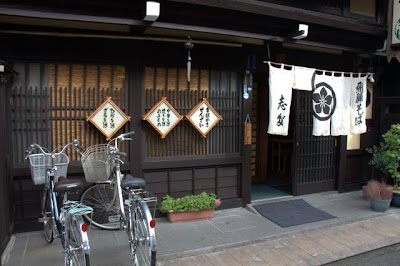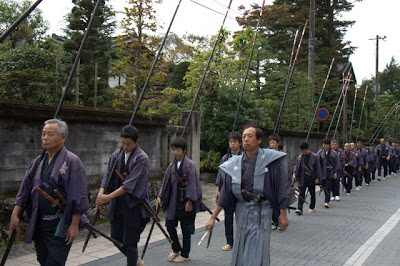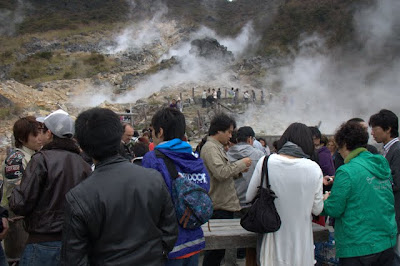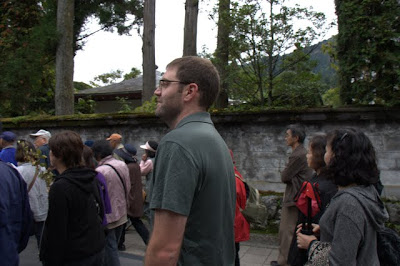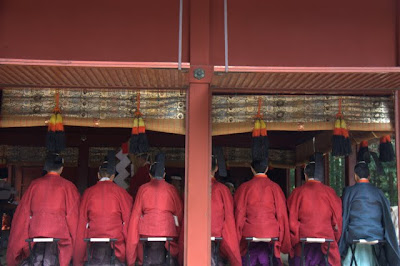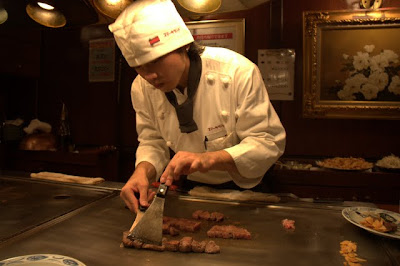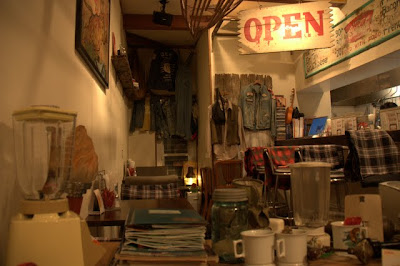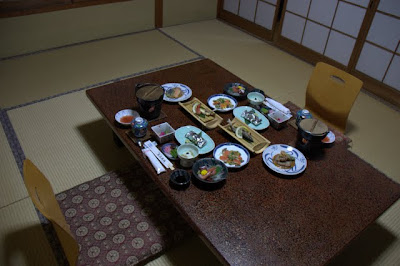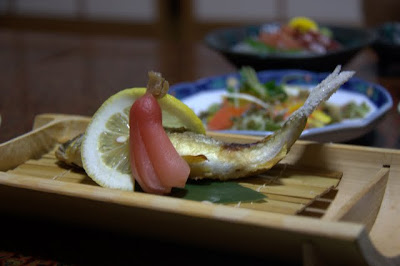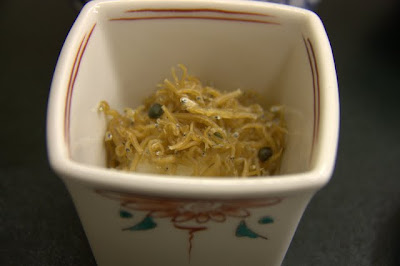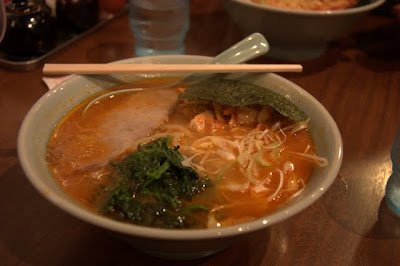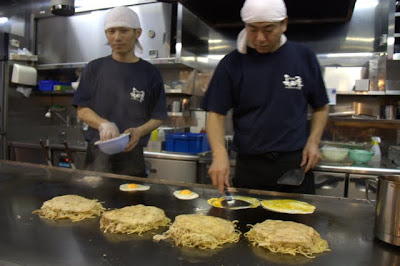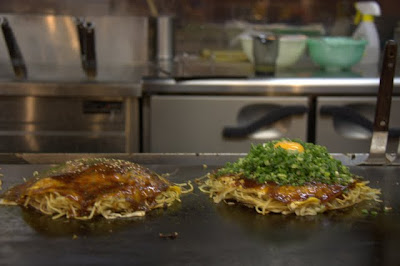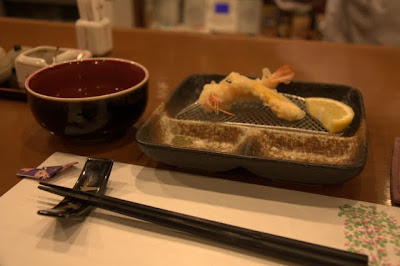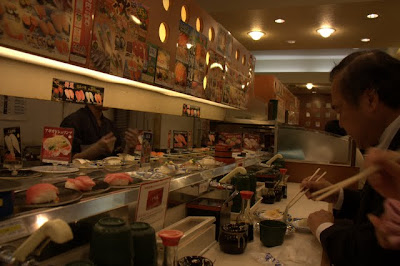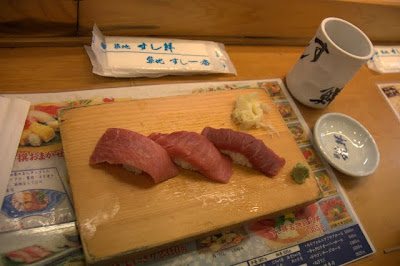Adventures in Eating in Japan, Part Two
Undoubtedly, eating in Japan is a big part of the adventure of traveling through the country. Yesterday, I shared five of our most memorable meals during our Japanese travels. Here’s another five to finish up the list:
Budget Buster
Knowing that we are headed to India next, where the cow is sacred, and being less than an hour train ride away from Kobe, we decided to splurge on the infamous Kobe beef in Kobe. Allegedly, to get the Kobe beef designation, cows are bottle fed beer and massaged. I never could get a straight answer on whether this is true, but for the price we paid, let’s all pretend that it is. The Kobe beef label is slapped on every expensive piece of beef back home, but apparently in Japan it just means quality beef that comes from one specific area in Japan. My research indicated that Kobe beef can be somewhat hard to find in Kobe, but The Google led us to Steakland Kobe, located close to the train stations. Steakland Kobe reminded me of American Japanese steakhouses more than any other place at which we ate in Japan. We took seats around a grill and watched the grill master slice up the raw beef and cook it before us. Before you even eat it, you can tell that the beef is going to be incredibly rich from the intense marbling. In the end, we’re not sure that we were big fans. Naturally, they charge insanely high prices for Kobe beef in Kobe – our meals were a whopping $143! I’m not sure if it was the crazy high price we paid or the super beefy taste that made us disappointed, but within 45 minutes of entering the restaurant, we were back standing back on the streets of Kobe, trying to make ourselves feel better about our budget-busting meal, saying, well, I guess it was worth it just once, right? Right?
Mmmm….burgers
Our second foray into Japanese beefland was a little more budget friendly. You can get burgers all over the world, but most of them are sorry, greasy imitations of the burgers you can get back home. Who would have thought that we would find one of the best burgers of the trip in Takayama, a small (and adorable!) town in the Japanese Alps? It is rare, but sometimes some of the best meals in a country are not the native cuisine. (I’m remembering you, delicious Italian anniversary meal in Prague). Wanting to take a break from noodles and the like, we decided to check out Center 4 Hamburgers one night. The shop is decorated in an Americana country-western theme, which right there transports you far away from Japan. The burgers were juicy and flavorful, the cheese was actually cheddar, the tomatoes ripe and fresh, the fries were crispy, and, best of all, they had Heinz ketchup. Sean still maintains that our Irish beef burger in Donegal, Ireland is the trip’s best burger, but I think this burger in Takayama is a strong contender.
Big Apples
While we struck out on seeing lots of koyo (autumn leaves), the best part of being in Japan in the fall was the apples. Once we got over the sticker shock of paying a couple of dollars per apple, we ponied up the money to try them. The apples in Japan are huge, juicy and sweet. As we were eating Fuji apples in Hakone, a town with views of Mt. Fuji on a clear day, it suddenly occurred to me where Fuji apples got their name. Duh.
The Japanese seem to be very particular about their apples. Most places, even roadside stands, wrap the apples individually in styrofoam netting. When we pursued the apples to find a small one we could afford, the woman selling them kept repeating in broken English, hai, hai, find a good one. No bruises.
Organic yumminess
I am drawn to any organic restaurants, cafes, or shops I see on the road like a fly is drawn to honey. We came across two in Japan, and both were tasty treats. My favorite was Myogaya, a little homey place in Takayama. It took forever to get our food because it was made from scratch by the owner. I thought it was worth the wait. The brown rice was a nutty diversion from the bucketloads of white rice we’d been consuming, and it was fun eating the variety of little organic dishes on my plate.

As I think the first two mentions in this post shows, I could never fully commit to vegetarianism, but I like to dabble in vegetables from time to time. The organic veggie platter at Myogaya.
Meals that Look Back at You
A quintessential Japanese experience is staying at a ryokan, a traditional Japanese inn where you receive impeccable service, sleep on the floor on futons, walk around in slippers, and bathe at the inn’s onsen. We stayed at Kamesei Ryokan in Chikuma City, located in the Nagano Prefecture in the mountains. While the inn turned out to be a little more dated and less rural than we thought, the service from Tyler, an American, and his Japanese wife and in-laws was fantastic, and our meal was a great experience. We were served dinner on a low table in our room. We sat on the floor to eat, as Tyler paraded in dish after dish after dish. Our table was covered with little dishes by the time he was done, and he took the time to explain them all to us. The next morning, we had breakfast in a similar fashion. It was fun sampling all different kinds of Japanese food in one meal. After several weeks in Japan, we even felt brave enough to sample one of the dishes containing little tiny squid, with their little beady eyes staring back at us.
Adventures in Eating in Japan, Part One
All of our meals in Japan proved to be an interesting experience. Some of the food is familiar, like sushi, teppanyaki, or ramen, but most of it is never exported off the islands. The problem with Japanese food is that you never know what you are going to get.
Some of it is just so foreign to our American palates that we were fearful each time we ordered that we were getting something totally weird. If you are lucky, you will get a menu with awkward translations into English. More often, you had to rely upon photographs of the food on the menus or the plastic replicas in the window, which usually made things look rather unappetizing.
We never ended up ordering anything too out of the ordinary, but did end up with some tasty meals. Here are our ten most memorable meals from Japan, in two parts:
Not your college ramen
Although my college friends subsisted off a diet solely composed of ramen, I never was that big of a fan. Perhaps it was because the college ramen was always a weak broth and a couple of wimpy noodles. Fukuouka, our first stop in Japan, is known for their ramen noodles. We tried it twice while we were there: once at a yakatori (a street stall) and once at Ramen Stadium, a whole floor on the top of a shopping mall devoted solely to ramen noodle restaurants, each featuring ramen from different regions around Japan. Ramen is a good value: filling, but cheap by Japan standards. Our favorite was the kind with red broth, which we think is from Northern Japan, but who can be sure. We’re just lucky that we actually selected ramen noodles, considering we had to order it from a vending machine that was entirely in Japanese.
Everything but the kitchen sink
Another “cheap” but unique experience was eating okynamiyaki. We first tried it in Hiroshima, where it was prepared right in front of us on teppan grills. Since we were in Hiroshima, the okynamiyaki was prepared Hiroshima style, meaning each ingredient is layered on top of the other. (We later tried it Osaka style in Kyoto, where all of the ingredients are mixed together. We preferred the Hiroshima approach). While we watched, the grillmaster cooked the okynamiyaki in stages: batter, egg, pork, sprouts, noodles, brown sweet-soy sauce, corn, and cheese. They were tasty and uniquely Japanese, but somewhat rich so we only had them a few times.
CoCo Curry regulars
It is safe to say that I enjoyed the food in Japan more than Sean, probably because it is heavily seafood based. Sean was always on the lookout for something more familiar. His favorite place to eat was CoCo Curry House, a chain in every city serving Japanese curry. Japanese curry is much milder than other Asian curries, although we never got more than a 2 spice level since each spice level was an additional cost. His favorite dish was a crispy breaded chicken curry dish served with rice. At around $25 USD for two curry meals and salads, CoCo Curry House was a good bargain. At the Tokyo location near our hotel, two sumo wrestlers were chowing down, so we figured they agreed.
Light and crispy
Trying to find someplace to eat one night in Kyoto, we wandered into a little neighborhood restaurant called Tempura Arima near our hotel. The prices were on the high side, but it looked good so we decided to stay. There were only six people in the restaurant: us, a Japanese couple, a husband cooking and a wife serving. The four customers took up almost all of the stools at the bar. Their specialty was multi-course tempura meals, so that is what we ordered. Each course was artfully presented, with delicate tastes. Despite the limited words we had in common, we managed to have a conversation with the Japanese owners and customers. They seemed to get a kick out of us maneuvering with our chopsticks and trying new things, and the other customers bought us shots of sake.
Going Raw
Ah, sushi. High end or low end, the sushi in Japan never disappointed and often was the one thing that was cheaper in Japan than it was at home. Although I shy away from wasabi at home, I found myself not only eating but enjoying the wasabi in Japan, prepared with fresh locally grown horseradish. My favorite fish was the tuna. If it was the good stuff – and most of it was – it was deep crimson in color and tasted so tender it was like it already had been cooked.
Among other places where we tried it, we ate sushi at a conveyor belt restaurant in Tokyo. The sushi keeps on rolling by. You pick what strikes your fancy and they tally up your plates at the end.
On our last full day in Japan, we wandered around Tokyo’s famous Tsukji Fish Market where the fish doesn’t get any fresher, then had sushi for breakfast at a nearby restaurant. Yum. For a good overview of how to eat sushi in Japan, check out Mary in Japan’s post on sushi etiquette.
